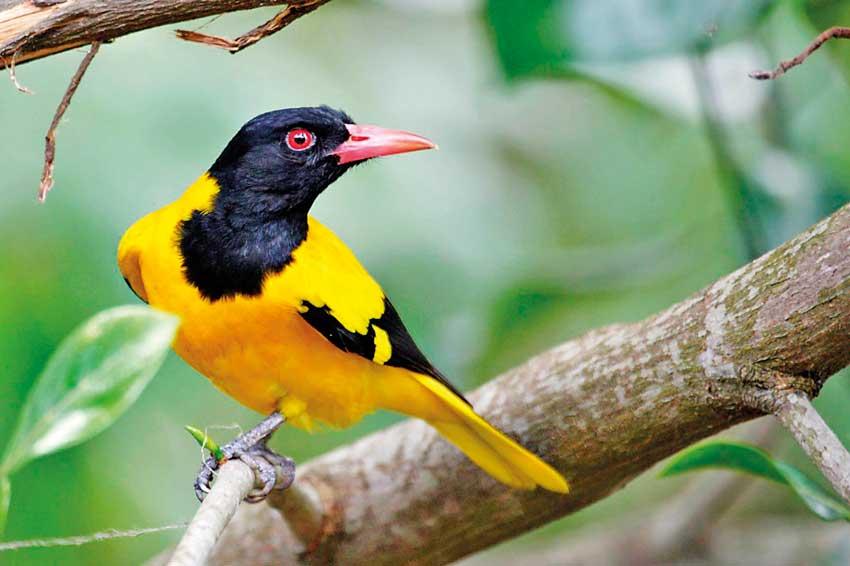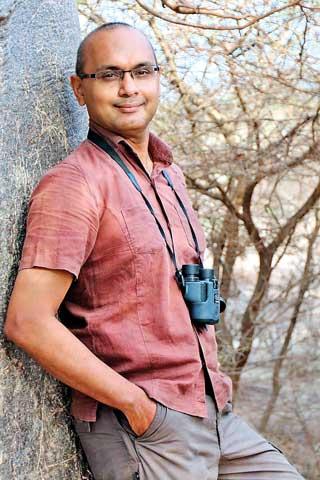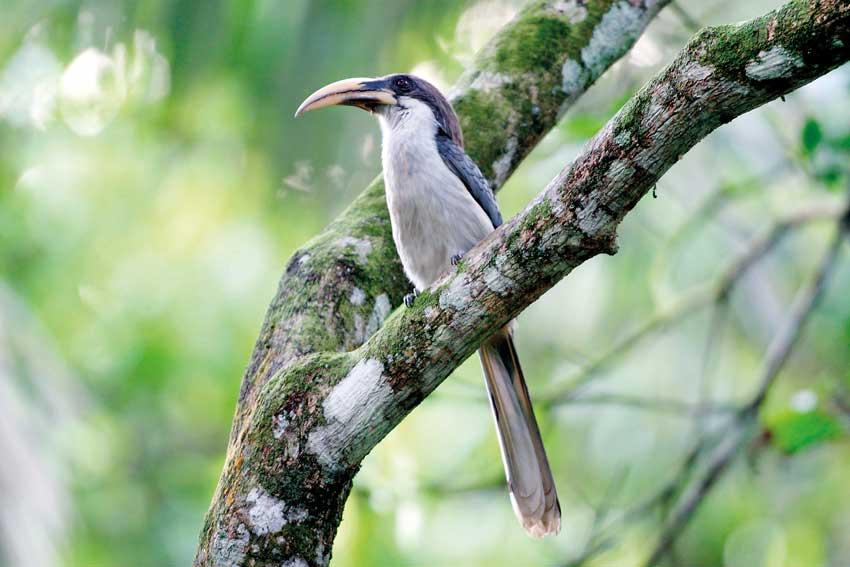07 Oct 2021 - {{hitsCtrl.values.hits}}
British company John Beaufoy Publishing has published a significantly revised third edition of A Naturalist’s Guide to the Birds of Sri Lanka. Previous editions of this pocket guide have served as a first book on bird-watching in Sri Lanka to many visitors and local residents. The third edition has been extensively revised to reflect current taxonomic thinking influenced by advances in molecular phylogenetics. The arrangement of birds to reflect their evolutionary relationship to each other is the science of taxonomy or systematics, which has been in a state of flux for centuries as taxonomists attempt to construct the evolutionary relationship between birds. The new arrangement of families will hold many surprises. For example, consider the familiar Sri Lanka Woodshrike, an endemic bird that is easily seen in popular dry lowland sites such as Yala. Many local birders will be surprised to find that it is now included in the family Vangidae, which comprises birds known as Vangas better known from Madagascar. The exact placement of some bird species still remains unresolved despite significant advances in genome sequencing.
In the current book, despite its compact size, 278 species of birds from 80 families within 22 scientific orders are covered

In the current book, despite its compact size, 278 species of birds from 80 families within 22 scientific orders are covered. The book’s author and principal photographer is Gehan de Silva Wijeyeratne, one of Sri Lanka’s best known natural history popularisers and a strong advocate of aligning conservation with an economic agenda. According to him, despite Sri Lanka being a moderate-sized island, it is a fantastic place in which to learn about birds. Over a third of the world’s bird families from over half of the world’s scientific orders are found in Sri Lanka. As a result Sri Lankan birders are familiar with many of the bird families found in Europe, Asia and Africa. Many visiting birders and photographers also comment on how remarkably easy it is to get close to stunning birds in Sri Lanka. Even in the capital city, colourful birds such as the Black-headed Oriole visit home gardens. Colombo is also blessed with biodiversity-rich urban wetlands such as Thalangama Wetland, Diyasaru Wetland Park and Beddegana Wetland where a spectacular array of birds from Grey-headed Swamp hen to Oriental Honey-buzzard can be seen.
 Add to the mix that the country has 34 endemic birds, it is not hard to see why Sri Lanka is spectacular for birds. De Silva Wijeyeratne also authored the first complete photographic field guide to the birds of Sri Lanka. This was also published by John Beaufoy Publishing and is now in its second edition. In contrast, A Naturalist’s Guide to the Birds of Sri Lanka is much more compact and focuses on the commoner birds. It is a portable book in a pocket size (18 cm tall, 13cm wide) and affordable. The book’s front sections include an introduction to the physical geography of Sri Lanka, the top birding sites, an illustrated listing of the 34 endemic birds, a summary listing of vagrants and bird topography. The end sections include a compete checklist of birds recorded in Sri Lanka, a listing of the main birding tour operators and a select bibliography.
Add to the mix that the country has 34 endemic birds, it is not hard to see why Sri Lanka is spectacular for birds. De Silva Wijeyeratne also authored the first complete photographic field guide to the birds of Sri Lanka. This was also published by John Beaufoy Publishing and is now in its second edition. In contrast, A Naturalist’s Guide to the Birds of Sri Lanka is much more compact and focuses on the commoner birds. It is a portable book in a pocket size (18 cm tall, 13cm wide) and affordable. The book’s front sections include an introduction to the physical geography of Sri Lanka, the top birding sites, an illustrated listing of the 34 endemic birds, a summary listing of vagrants and bird topography. The end sections include a compete checklist of birds recorded in Sri Lanka, a listing of the main birding tour operators and a select bibliography.
The species accounts are complemented with excellent photographs that are useful for field identification. The new edition also includes several images from local photographers including Namal Kamalgoda, Udaya Karunaratne, Gehan Rajeev, Ajith Ratnayake, Mohammed Abidally and Athula Edirisinghe. According to John Beaufoy, this is one of eight books on Sri Lanka’s fauna and flora by John Beaufoy Publishing (JBP). Seven of them have Gehan as an author and photographer. Beaufoy notes that Gehan is amongst a small handful of author-cum-photographers in the world who have written and photographed natural history field guides across such a wide range of subjects. Rosemary Wilkinson who oversees the publishing programme at John Beaufoy Publishing adds that Gehan was the first in Sri Lanka to develop photographic field guides to birds, mammals, butterflies and dragonflies. Bill Oddie, the widely travelled British wildlife presenter has stated, no individual has done so much to brand a country as a wildlife destination as Gehan has done with Sri Lanka.
Previous editions of this pocket guide have served as a first book on bird-watching in Sri Lanka to many visitors and local residents
According to Wilkinson, Gehan’s engagement with conservation circles in the UK and Sri Lanka helps him to understand what both a local and international readership wants from his books. Presently, Gehan is Chair of the London Bird Club (a section of the London Natural History Society) and is also a Trustee of the British Ornithologists’ Club, two societies each having over a hundred years of history in both science and public engagement.
According to Charmarie Maelge, a former Managing Director of the Sri Lanka Tourism Promotion Bureau (SLTPB), Gehan’s impact goes far beyond his efforts as a natural history populariser. She points out that Gehan was the person who made the tourism industry understand that Sri Lanka is one of the best all-round wildlife destinations in the world. Nalin Perera is another Sri Lankan who like Maelge was in charge of the London office of the SLTPB. He has handed out thousands of flyers at tourism fairs promoting Sri Lankan wildlife which were prepared for him by Gehan. According to him, a combination of field work, a deep interest in science, an ability to write, photograph, public speak and an eye for a good story helped Gehan to convince the media and the tourism industry that Sri Lanka is an outstanding all-round wildlife destination. According to Perera, many people in Sri Lanka with jobs in wildlife tourism have benefitted from Gehan’s efforts.
The third edition has been extensively revised to reflect current taxonomic thinking influenced by advances in molecular phylogenetics
Gavin Thomas, the author of the Rough Guide to Sri Lanka who has visited Sri Lanka many times over the last few decades, has seen the changes. These little books are powerful he says. Both local and foreign visitors gift these books to local guides and it helps to develop capacity. Thomas has travelled extensively around the world and is impressed with what he sees in Sri Lanka. It has an impressive network of parks and reserves, passionate and skilled local guides who know their wildlife, books on its wildlife and a mature tourism industry with a broad range of accommodation and tour operators. It also punches above its weight in the number of specialist wildlife tour operators, including the specialist subsidiaries of the tourism heavyweights. He says ‘Sri Lanka has benefitted enormously from Gehan’s pioneering efforts and his talent for branding the island for Leopard Safaris, the biggest recurring wild elephant gathering in the world, the best for sighting the Blue Whale and the best chance for seeing a super-pod of Sperm Whales’.

What would Gehan like to see in the future? He thinks it is critical that more re-wilding takes place to protect biodiversity and the watershed. He would also like to see cities such as Colombo have areas where native dipterocarps are grown. Dipterocarps which are mainly an Asian family are the forest giants of the world and taller in stature than trees in other rainforests like the well known Amazon. Fifty-one of 52 dipterocarp species found in Sri Lanka are endemic, that is seen nowhere else in the world. Visiting birdwatchers in search of endemic birds visit rainforests such as Bodhinagala and Sinharaja and Kithulgala and see these very special trees. He finds it odd that these trees which form bio-diverse forests are absent, unknown and unseen by city dwellers. Colombo has a superb portfolio of wetland sites thanks to intelligent and visionary management by government agencies. He thinks it would be wonderful for city dwellers to have native trees planted in mini arboretums so that they can better appreciate the country’s forest giants.
At the time of writing, Sri Lanka has come off the red list of countries such as the UK and is poised to benefit from the resumption of international travel after nearly two years of Covid. JBP currently have in print ‘Naturalist’s Guide’ titles covering birds, butterflies and dragonflies, mammals, flowers, trees and reptiles as well as the larger format book ‘Wild Sri Lanka’. John Beaufoy is confident that tourism will recover in Sri Lanka and states that he hopes to be publishing more books on Sri Lanka in the future.
26 Nov 2024 47 minute ago
26 Nov 2024 1 hours ago
26 Nov 2024 1 hours ago
26 Nov 2024 2 hours ago
26 Nov 2024 3 hours ago